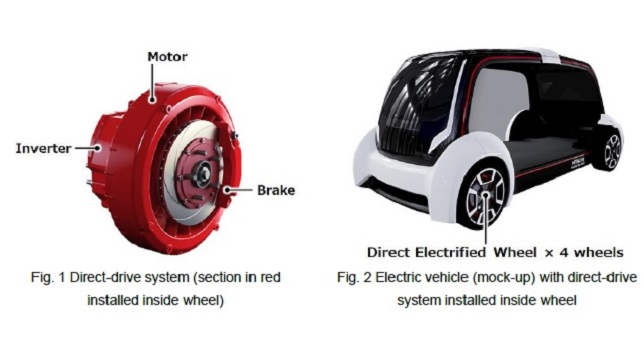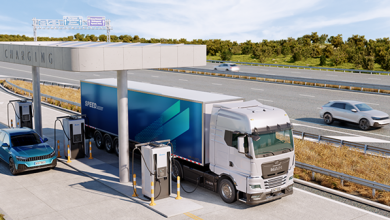Hitachi and Hitachi Astemo develop new compact, lightweight direct-drive system for in-wheel applications

Hitachi, Ltd. and Hitachi Astemo, Ltd. jointly announced the development of a compact, lightweight direct-drive system for the increasingly popular EV segment, which combines the motor, inverter, and brake into a single unit (Fig. 1). This enables the installation of the entire system into the wheel, thus moving the world one step closer to a zero-emissions society. The new motor transmits the high drive force necessary to run an EV directly to the wheels, and its lightweight design and world-class 2.5 kW/kg power density significantly limit the weight increase traditionally associated with in-wheel units. Moreover, adoelepting an in-wheel unit does not require a substantial change to the existing configuration of the suspension and other components. Driveshafts and other indirect mechanisms have been eliminated, allowing motor power to be applied directly to EV operation. This reduces energy loss by 30 percent and increases the range on a single charge compared to existing EVs.
Hitachi and Hitachi Astemo will continue research into the practical implementation of the technology, which enables more expansive interior and battery installation spaces. In addition to the vehicle control technology it has been developing, Hitachi Astemo will apply the new direct-drive system to its already extensive, global EV product lineup.
Background and additional information
There is growing investment activity and technological development towards realizing a decarbonized society. In the motor vehicle sector, there is an especially strong legislative push for transitioning from gasoline-driven vehicles to EVs. In conventional EVs, the drive system is placed on the chassis, which limits interior and/or battery space. Fitting the motor inside a wheel has been identified as a solution, but this increases the weight in the wheel and requires sweeping changes to the existing brake and suspension components.
To address this, Hitachi and Hitachi Astemo’s lightweight direct-drive system-drawing on Hitachi Group’s broad technology and product development in the mobility space that includes railways and elevators-combines motor, inverter, and brake into a single in-wheel unit for EVs. The features of the technology are as follows:
1. Halbach array magnets and innovative flat coils produce world-class power density
Increasing the number of magnetic poles is effective in improving a motor’s drive force, but has shortcomings-namely, that it reduces the proportion of magnetic flux that can be effectively used, and necessitates more coil weld points and welding space. By placing the magnets in a Halbach array, Hitachi and Hitachi Astemo have succeeded in improving drive force by increasing the effective magnetic flux of each magnetic pole, and made the motor lighter by using beam welding to create a high-density array of flat coils, thus achieving world-class 2.5 kW/kg power density. This limits the in-wheel weight increase of the EV, and avoids the increased energy consumption that’s characteristic of conventional, heavier in-wheel systems.
2. Direct-drive system incorporating a single motor, inverter, and brake unit
Prior EV motors have low power density and monopolize space inside the wheel to provide sufficient drive force, which makes it difficult to use existing brakes and suspension components. Space is also needed for a dedicated and electrically insulated coolant channel, which prevents electrical faults from occurring when power semiconductors in the inverter come in contact with coolant. The newly developed system uses direct-cooling technology, in which high-insulating cooling oil directly cools the power semiconductors and is cycled to the motor to directly cool the coils. This combined with the single-unit drive system-which integrates a motor, brake and inverter-significantly reduces the space taken up by cooling pipes and enables in-wheel installation without having to significantly alter the existing configuration of suspension and other components.
Specifications of direct-drive system
| Item | Value |
|---|---|
| Motor power density | 2.5 kW/kg |
| Wheel size | 19 in. |
| Maximum output | 60 kW |
| Maximum torque | 960 Nm |
| Supplied voltage | 420 V |
| Maximum electric current | 280 A |


